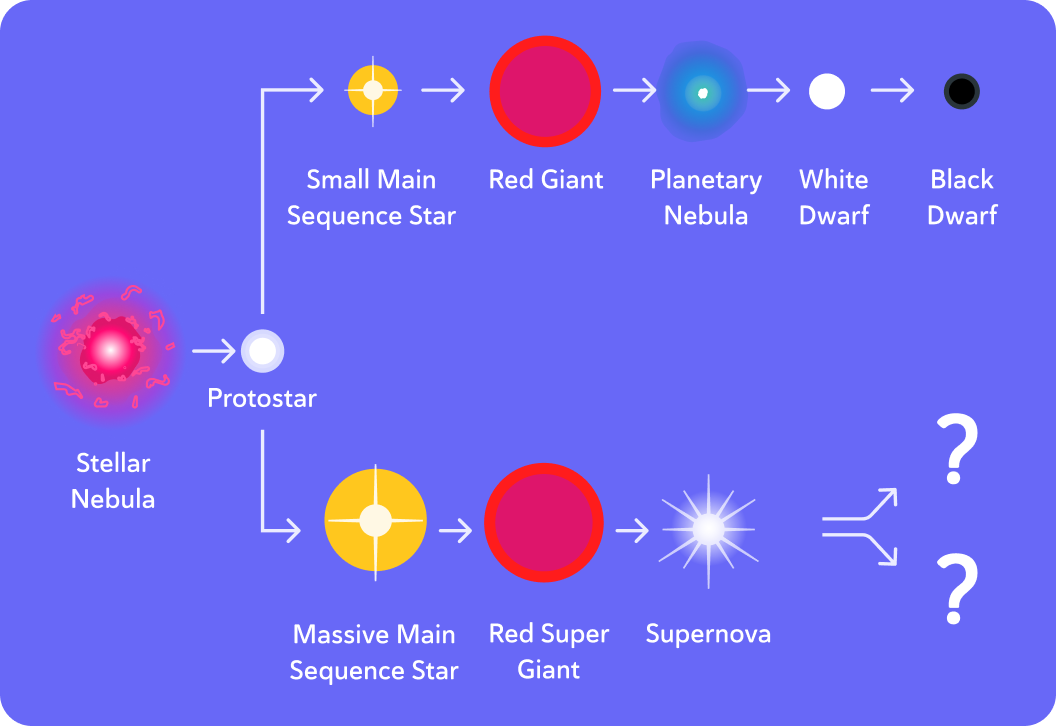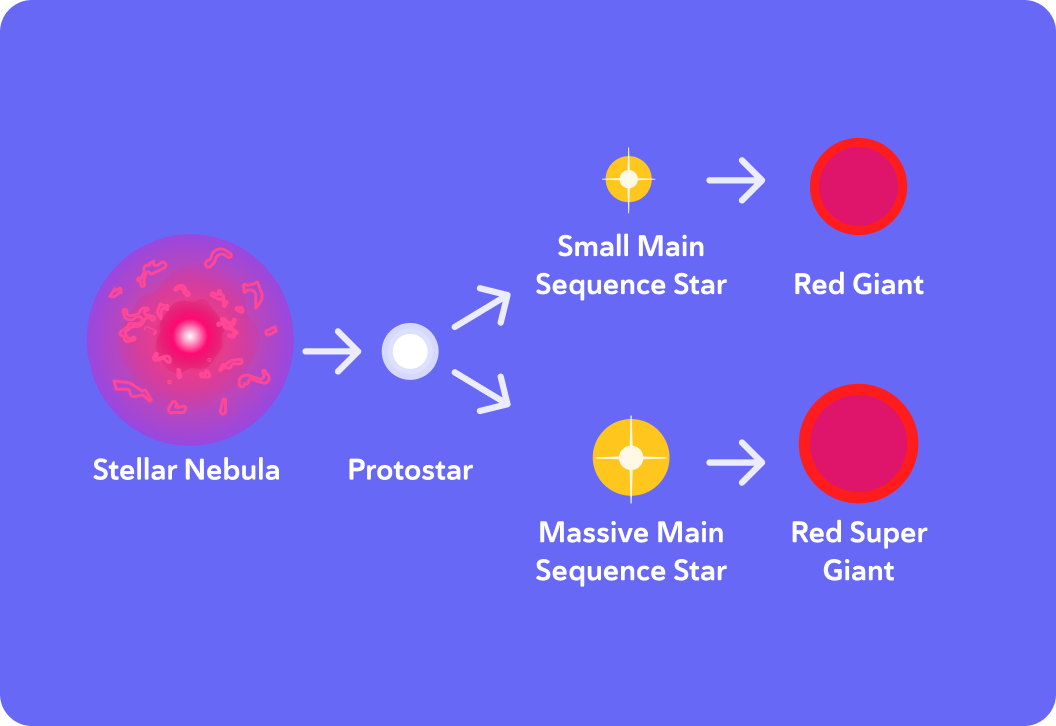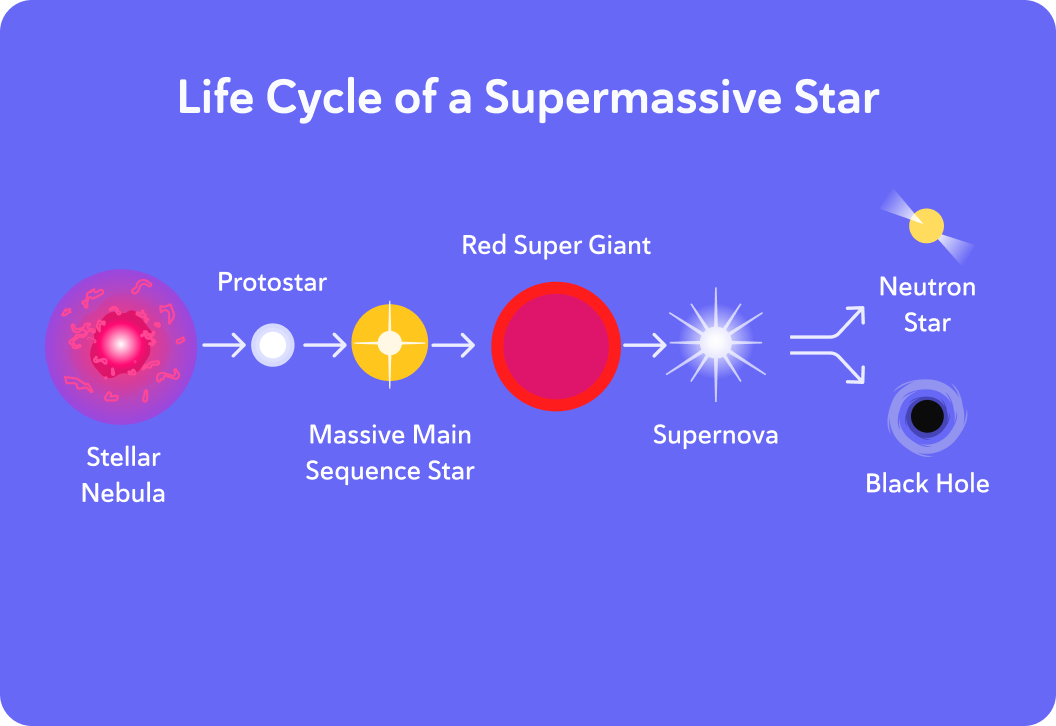YOU ARE LEARNING:
Life Cycle of Supermassive Stars

Life Cycle of Supermassive Stars
Stars much larger than our Sun have more gravity, resulting in supernovae, neutron stars and even black holes!
What do we call the cloud of dust and gas that all stars start off as?

After some time, gravity pulls together the dust and hydrogen that makes up a nebula to form what?

After some time a protostar gets denser and hotter, and nuclear fusion begins in its core. What do we call the next step in this star's life?

To recap
So all stars begin as a nebula
A nebulae are clouds of dust and gas (hydrogen).
The nebula will turn into a protostar
This happens when gravity pulls the dust and gas together.
The protostar will turn into a main sequence star
This happens once the pressure and the temperature in the protostar has risen so much that nuclear fusion of hydrogen will start.
The life cycle of stars
Now, stars that are around the size of our Sun will turn into _______ ________ after several billion years of being a main sequence star.

Stars like our Sun turn into red giants when their hydrogen runs out and they have to start fusing heavier elements.
This produces more energy and pressure in the star, and that makes it expand and get even hotter.
However, stars the size of our Sun are actually quite small compared to other stars!
So what happens to stars that are much bigger than our Sun?
Essentially, the same thing happens, but on a super large scale. So we don't call these giants "red giants". We call them "red ________giants".

What happens after the red supergiant stage?
Red supergiants shine brightly again because they undergo even more nuclear fusion than red giants.
In fact, they pass through several cycles of expansion and contraction, and they end up forming elements as heavy as iron.
After some time, the red supergiant fuses all of its fuel into a large core of iron.
Iron is no good as fuel for fusion as it is the most stable element, so fusion stops. Without fusion, there is no pressure going outwards, so gravity exerts a lot of force on the iron core.
Eventually, the gravitational force on the core makes it explode. What do we call that explosion? It begins with an "S".

So red supergiants eventually explode in a supernova, ejecting heavy elements across the universe.
What happens next depends again on the size of the original star.
This shows the timeline of both smaller stars, like our Sun, and much larger stars
We know what happens up until red supergiants explode into supernovae, but what happens after the supernovae is again dependent on exactly how big that star was.

After the supernova has exploded only the core of the red giant is left. It has compressed so much under its own gravity that protons and electrons have squashed together. What particle do you think they have become?


So we now have a dense core of neutrons. We simply call that a __________ star.


So very big stars condense into a very dense core called a neutron star.
A neutron star may have a diameter as small as 15km, but they are so dense that a teaspoon of neutron star would weigh 1013Newtons. That is roughly the same as five thousand cruise ships or five hundred million elephants!

If the star was even more massive than the stars that become neutron stars, it would becomes something else after it exploded into a supernova. It's gravity would cause it to collapse in on itself and it would become one of the most massive and dangerous objects in the universe. What would it become?


Absolutely massive stars collapse in on themselves and create a black hole
They are called "black holes" because they are so dense that everything gets sucked in by them - even light! This means they appear as tiny holes in the universe where no light is ever emitted.

So to summarise! All stars are initially formed from a nebula.
Nebulae are clouds of dust and gas.

Nebulae become protostars
Very slowly the attractive forces of gravity pull dust and gas together.

Protostars become main sequence stars
This happens at the point when the pressure and temperature in the protostar is high enough that it can star to use up hydrogen in nuclear fusion.

After billions of years, the main sequence star becomes either a red giant or a red supergiant, depending on how much mass it had before.
This happens when the star has exhausted its supply of hydrogen and begins to fuse helium and heavier elements. This releases more energy and increases the outwards pressure, so the star expands and becomes hotter.

Stars that are about as big as our Sun (actually quite small) become a planetary nebula after the red giant stage
They have run out of fuel for fusion and have collapsed under their own gravity. The red giant throws off its outer layers in this nebula.

The planetary nebula that these quite small stars turn into eventually reveal a hot dense core.
We call that a white dwarf. The white dwarf eventually cools and becomes a black dwarf.

Much more massive stars than our Sun eventually explode into supernovas.
This ejects heavy elements across the Universe.

After the supernova explosion, gravity condenses what's left into a very dense object.
Depending on the mass of the original star this will be a neutron star (for large stars) or a black hole (for extremely massive stars).

